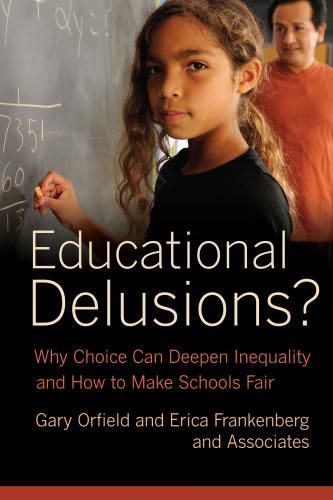Educational Delusions?
Educational Delusions?
Why Choice Can Deepen Inequality
and How to Make Schools Fair
Gary Orfield and Erica Frankenberg
and Associates
UNIVERSITY OF CALIFORNIA PRESS
BerkeleyLos AngelesLondon
University of California Press, one of the most distinguished university presses in the United States, enriches lives around the world by advancing scholarship in the humanities, social sciences, and natural sciences. Its activities are supported by the UC Press Foundation and by philanthropic contributions from individuals and institutions. For more information, visit www.ucpress.edu.
University of California Press
Berkeley and Los Angeles, California
University of California Press, Ltd.
London, England
© 2013 by The Regents of the University of California
Library of Congress Cataloging-in-Publication Data
Educational delusions? : why choice can deepen inequality and how to make schools fair / Gary Orfield and Erica Frankenberg and associates.
p. cm.
Includes bibliographical references and index.
ISBN 978-0-520-27473-0 (cloth : alk. paper)—ISBN 978-0-520-27474-7 (pbk. : alk. paper)
eISBN 9780520955103
1. School choice. 2. Educational equalization. I. Orfield, Gary, editor of compilation. II. Frankenberg, Erica, editor of compilation.
LB1027.9.E395 2013
379.2'6—dc232012040600
Manufactured in the United States of America
22 21 20 19 18 17 16 15 14 13
10 9 8 7 6 5 4 3 2 1
In keeping with a commitment to support environmentally responsible and sustainable printing practices, UC Press has printed this book on 50-pound Enterprise, a 30% post-consumer-waste, recycled, deinked fiber that is processed chlorine-free. It is acid-free and meets all ANSI/NISO (z 39.48) requirements.
CONTENTS
List of Illustrations
Acknowledgments
PART ONE. INTRODUCTION
1.Choice and Civil Rights: Forgetting History, Facing Consequences
Gary Orfield
2.Choice Theories and the Schools
Gary Orfield
PART TWO. SCHOOL DISTRICTS’ USE OF CHOICE TO FURTHER DIVERSITY
3.The Promise of Choice: Berkeley's Innovative Integration Plan
Erica Frankenberg
4.Valuing Diversity and Hoping for the Best: Choice in Metro Tampa
Barbara Shircliffe and Jennifer Morley
5.Designing Choice: Magnet School Structures and Racial Diversity
Genevieve Siegel-Hawley and Erica Frankenberg
PART THREE. CHARTER SCHOOLS AND STRATIFICATION
6.A Segregating Choice? An Overview of Charter School Policy, Enrollment Trends, and Segregation
Erica Frankenberg and Genevieve Siegel-Hawley
7.Failed Promises: Assessing Charter Schools in the Twin Cities
Myron Orfield, Baris Gumus-Dawes, and Thomas Luce
8.The State of Public Schools in Post-Katrina New Orleans: The Challenge of Creating Equal Opportunity
Baris Gumus-Dawes, Thomas Luce, and Myron Orfield
PART FOUR. LESSONS ABOUT CONDITIONS UNDER WHICH CHOICE FURTHERS INTEGRATION
9.The Story of Meaningful School Choice: Lessons from Interdistrict Transfer Plans
Amy Stuart Wells, Miya Warner, and Courtney Grzesikowski
10.School Information, Parental Decisions, and the Digital Divide: The SmartChoices Project in Hartford, Connecticut
Jack Dougherty, Diane Zannoni, Maham Chowhan, Courteney Coyne, Benjamin Dawson, Tehani Guruge, and Begaeta Nukic
11.Experiencing Integration in Louisville: Attitudes on Choice and Diversity in a Changing Legal Environment
Gary Orfield and Erica Frankenberg
Conclusion: A Theory of Choice with Equity
Gary Orfield and Erica Frankenberg
References
Contributors
Index
ILLUSTRATIONS
FIGURES
7.1.Students of color in segregated school settings by school type, Twin Cities
7.2.Poverty and math proficiency rates in Twin Cities elementary schools, 2007-8
8.1.Fourth grade pass rates, 2009
8.2.Eighth grade pass rates, 2009
8.3.Percentage point change in fourth grade pass rates, 2007-9
8.4.Percentage point change in eighth grade pass rates, 2007-9
9.1.Declining enrollments of interdistrict school desegregation plans
10.1.Minority and Connecticut Mastery Test goal-achievement percentages of public school options available to Hartford K-8 families, 2010-11
11.1.Jefferson County Public School students’ advice on future diversity efforts, 2011
TABLES
3.1.Deviation from system-wide racial and economic composition in BUSD among elementary schools, 2008-9
3.2.Requests for kindergarten made by families in round 1, 2008-9
3.3.Berkeley elementary school seats, first-choice requests, and matriculation rates for round 1 of kindergarten placement, 2008-9
5.1.Magnet versus nonmagnet district enrollment patterns by race, 2008-9
6.1.Percentage of charter and public school students in segregated minority schools, by race/ethnicity, 2007-8
8.1.Percentage composition of schools by sector, city of New Orleans
8.2.Percentage of students per school sector, city of New Orleans
9.1.Key characteristics of charter school and voucher plans versus interdistrict desegregation plans
10.1.Number of participants who changed their top-choice school postworkshop, by school characteristics
11.1.Satisfaction with school assignment for your child
11.2.Factors impacting school choice
ACKNOWLEDGMENTS
Choice has been a major theme in civil rights policy since the 1960s. One of us, Erica Frankenberg, is the product of a good desegregated magnet school in Mobile, Alabama; the other, Gary Orfield, had his children attend a magnet school in Illinois and was deeply involved in the creation of new magnet schools in St. Louis and San Francisco, where federal courts appointed
